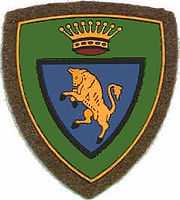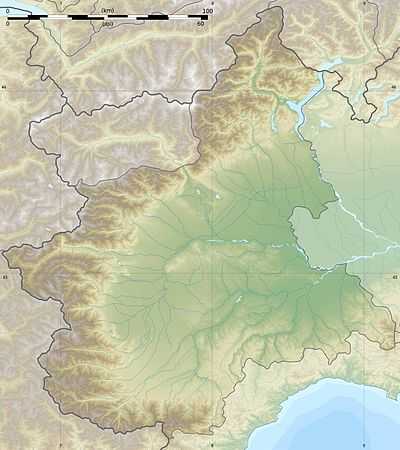Alpine Brigade Taurinense
| Brigata Alpina "Taurinense" | |
|---|---|
|
Coat of Arms Taurinense Alpine Brigade | |
| Active | 15 April 1952 – today |
| Allegiance | Italian Army |
| Branch | Army |
| Type | Brigade |
| Role | Alpini |
| Part of | Tridentina Division Command |
| Garrison/HQ | Turin |
| Colors | green |
| Engagements |
Iraq Operation Provide Comfort Bosnia SFOR Mozambique ONUMOZ Kosovo KFOR Afghanistan ISAF |
| Commanders | |
| Current commander | Brigadier Federico Bonato |
The Alpine Brigade Taurinense is a light Infantry brigade of the Italian Army, specializing in Mountain Combat. Its core units are the Alpini, the mountain infantry corps of the Italian Army, that distinguished itself in combat during World War I and World War II. The brigade’s name Taurinense alludes to the Roman name Augusta Taurinorum of the city of Turin around which the brigade is based. The Brigade carries on the name and traditions of the 1st Alpine Division Taurinense.
History
Constitution
The Taurinense was constituted on 15 April 1952 in the city of Turin. Initially the brigade was part of the III Army Corps was composed of the:
-
 HQ & HQ Platoon
HQ & HQ Platoon -
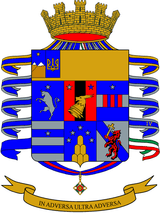 4th Alpini Regiment with
4th Alpini Regiment with
-
 Headquarters Platoon
Headquarters Platoon -
 Aosta Alpini Battalion
Aosta Alpini Battalion -
 Saluzzo Alpini Battalion
Saluzzo Alpini Battalion -
 Susa Alpini Battalion
Susa Alpini Battalion -
 4th Mortar Company
4th Mortar Company
-
-
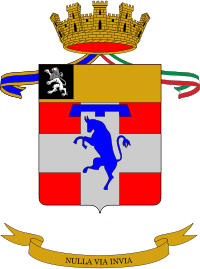 1st Mountain Artillery Regiment with
1st Mountain Artillery Regiment with
- Aosta Mountain Artillery Group
- Susa Mountain Artillery Group
- Pinerolo Mountain Artillery Group
- Light Air-defense Group (disbanded on 1 January 1956)
-
 Mixed Engineer Company (later split into a Signal Company and an Engineer Company)
Mixed Engineer Company (later split into a Signal Company and an Engineer Company)
In the following years the brigade was augmented with further units:
-
 Mondovi Alpini Battalion (1953) as 4th battalion of the 4th Alpini Regiment
Mondovi Alpini Battalion (1953) as 4th battalion of the 4th Alpini Regiment -
 Alpini Parachutist Platoon (1953)
Alpini Parachutist Platoon (1953) - Light Army Aviation Company (1958)
In 1962 the Mondovi Alpini Battalion and Pinerolo Mountain Artillery Group were transferred to the region of Friuli-Venezia Giulia to augment the Alpine Brigade Julia and in 1963 the Aosta Alpini Battalion was transferred to the Alpini Formation and Training Center in Aosta, but returned to the 4th Alpini Regiment in 1967. On 1 April 1964 the Alpini Parachutist Platoon merged with the other four Alpini Brigades Parachutist Platoons to form an Alpini Parachutist Company under direct command of the IV Army Corps. On 1 June 1966 the 2nd Alpini (Training) Regiment, with four battalions named for the four Alpini brigades to which the conscripts were sent after training: Tridentina, Orobica, Cadore and Taurinense, was transferred to the Taurinense. In 1970 the Mondovi Mountain Artillery Group was raised and added to the 1st Mountain Artillery Regiment. Thus in 1972 when the brigade was transferred from the III Army Corps to the IV Army Corps it consisted of the following units:
-
 4th Alpini Regiment with
4th Alpini Regiment with
-
 Aosta Alpini Battalion
Aosta Alpini Battalion -
 Saluzzo Alpini Battalion
Saluzzo Alpini Battalion -
 Susa Alpini Battalion
Susa Alpini Battalion
-
-
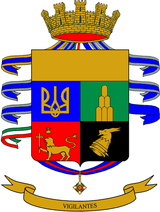 2nd Alpini Training Regiment with
2nd Alpini Training Regiment with
- Cadore Alpini Training Battalion
- Orobica Alpini Training Battalion
- Taurinense Alpini Training Battalion
- Tridentina Alpini Training Battalion
-
 1st Mountain Artillery Regiment with
1st Mountain Artillery Regiment with
- Aosta Mountain Artillery Group
- Susa Mountain Artillery Group
- Mondovi Mountain Artillery Group
-
 Taurinense Logistic Service Battalion
Taurinense Logistic Service Battalion - Taurinense Light Army Aviation Company
-
 Taurinense Engineer Company
Taurinense Engineer Company -
 Taurinense Signal Company
Taurinense Signal Company
1975 Reorganization
On 1 October 1975 the regimental level was abolished by the Italian Army. The remaining units came under direct control of the Taurinense Brigade. Also the Aosta Alpini Battalion was once more transferred to the Alpini Formation and Training Center, the Susa Mountain Artillery Group was renamed Pinerolo and the Mondovi Mountain Artillery Group was dissolved. The 2nd Alpini Training Regiment had already been dissolved in 1974 and its four battalions were merged into a single Alpini Training Battalion. In 1975 the Taurinense Logistic Battalion was formed. The new composition was therefore:
-
 Taurinense Command and Signal Battalion in Turin
Taurinense Command and Signal Battalion in Turin -
 Mondovi Alpini (Training) Battalion in Cuneo
Mondovi Alpini (Training) Battalion in Cuneo
-
 Headquarters and Service Company
Headquarters and Service Company -
 9th Alpini (Training) Company
9th Alpini (Training) Company -
 10th Alpini (Training) Company
10th Alpini (Training) Company -
 11th Alpini (Training) Company
11th Alpini (Training) Company -
 103rd Alpini (Training) Company
103rd Alpini (Training) Company
-
-
 Saluzzo Alpini Battalion in Borgo San Dalmazzo
Saluzzo Alpini Battalion in Borgo San Dalmazzo
-
 Headquarters and Service Company
Headquarters and Service Company -
 21st Alpini Company
21st Alpini Company -
 22nd Alpini Company
22nd Alpini Company -
 23rd Alpini Company
23rd Alpini Company -
 106th Heavy Mortar Company
106th Heavy Mortar Company
-
-
 Susa Alpini Battalion in Pinerolo
Susa Alpini Battalion in Pinerolo
-
 Headquarters and Service Company
Headquarters and Service Company -
 34th Alpini Company
34th Alpini Company -
 35th Alpini Company
35th Alpini Company -
 36th Alpini Company
36th Alpini Company -
 133rd Heavy Mortar Company
133rd Heavy Mortar Company
-
-
 Aosta Mountain Artillery Group in Saluzzo
Aosta Mountain Artillery Group in Saluzzo
-
 Headquarters and Service Battery
Headquarters and Service Battery -
 4th Mountain Artillery Battery
4th Mountain Artillery Battery -
 5th Mountain Artillery Battery
5th Mountain Artillery Battery -
 6th Mountain Artillery Battery
6th Mountain Artillery Battery
-
-
 Pinerolo Mountain Artillery Group in Susa
Pinerolo Mountain Artillery Group in Susa
-
 Headquarters and Service Battery
Headquarters and Service Battery -
 7th Mountain Artillery Battery
7th Mountain Artillery Battery -
 8th Mountain Artillery Battery
8th Mountain Artillery Battery -
 40th Mountain Artillery Battery
40th Mountain Artillery Battery
-
-
 Taurinense Logistic Battalion in Rivoli
Taurinense Logistic Battalion in Rivoli -
 Taurinense Anti-tank Company in Turin
Taurinense Anti-tank Company in Turin -
 Taurinense Engineer Company in Abbadia Alpina
Taurinense Engineer Company in Abbadia Alpina - Light Army Aviation Squadron (renamed 4th Reconnaissance Helicopter Squadron and transferred to the 4th Light Aviation Regiment Altair in Bolzano on 31 January 1976)
-
On 1 June 1978 the Taurinense Air-transportable Medical Group was raised as a rapid deployable medical asset. The only such unit in the Italian Army.
Strategic plans in case of war
After the 1976 reform the 4th Alpine Army Corps was responsible to defend the Italian border along the main chain of the alps from the Swiss-Austrian-Italian border tripoint in the west to the Italian-Yugoslavian border in the east. In case of war with Yugoslavia the 4th Alpine Army Corps would remain static in its position guarding the left flank of the Italian V Corps, which would meet the enemy forces in the plains of Friuli-Venezia Giulia. The only brigade which would have seen combat in such a case would have been the Julia.
In case of a war with the Warsaw Pact the 4th Alpine Army Corps had two war planes: one in the case the Soviet Southern Group of Forces and Hungarian Army would march through Yugoslavia and the other in case the Warsaw Pact would violate the Austrian neutrality and march through Austria. In case the enemy forces would come through Yugoslavia, the Julia would cover the mountainous left flank of the 5th Corps, which with its four armoured and five mechanized brigades would try to wear down the enemy before it could break out into the North Italian Padan plain. The other Alpini brigades would remain static.
In the more likely case the Soviet and Hungarian divisions would invade Austria and march through Southern Styria and through the Drava valley in Carinthia the Alpini brigades would have been the first front line units of the Italian Army. The Julia would have defended the Canal valley, the Cadore the Piave valley and the Tridentina the Puster valley, while the Orobica was given a special mission. The Taurinense was to be kept in reserve and deployed as needed: either to reinforce the other Alpine brigades; or to block with the Parachute Brigade Folgore and Motorized Brigade Friuli the Apennine passes into central Italy in case enemy forces would have been able to cross the lower Adige and Po rivers; or to block the French-Italian mountain passes with the French 27th Mountain Infantry Brigade in case the Warsaw Pact would have conquered all of Northern Italy. In case the 5th Army Corps with reinforcement from the 3rd Army Corps would have been able to withstand the Warsaw Pact forces the Taurinense was Italys designated reinforcement for the Norwegian front.
1990s reorganization
On 23 March 1991 the Pinerolo Mountain Artillery Group was dissolved. On 1 August 1992 the Saluzzo Battalion was integrated in the reactivated 2nd Alpini Regiment. The same month the Anti-tank Company was disbanded. On 19 September 1992 the Aosta Artillery Group was integrated in the reactivated 1st Mountain Artillery Regiment. With the entry of the Susa Battalion into the reactivated 3rd Alpini Regiment on 23 October 1993 the reorganization of the brigade was for the time completed. Both Alpini regiments consisted of one battalion and a support company. The Command and Signal Battalion was merged with the Engineer Company into the newly formed Command and Tactical Support Battalion. The new composition was:
-
 2nd Alpini Regiment
2nd Alpini Regiment  Saluzzo Battalion
Saluzzo Battalion -
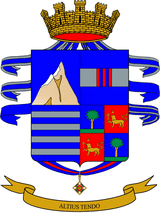 3rd Alpini Regiment
3rd Alpini Regiment  Susa Battalion
Susa Battalion -
 1st Mountain Artillery Regiment Aosta Artillery Group
1st Mountain Artillery Regiment Aosta Artillery Group -
 Mondovi Alpini Training Battalion
Mondovi Alpini Training Battalion -
 Taurinense Command and Tactical Support Battalion
Taurinense Command and Tactical Support Battalion -
 Taurinense Logistic Battalion
Taurinense Logistic Battalion
With the suppression of the Alpine Brigade Cadore in 1997, the two remaining regiments of that brigade passed to the Alpine Brigade Julia, which in turn ceded the 9th Alpini Regiment to the Taurinense. At the same time the Mondovi Alpini Training Battalion was dissolved. A fate shared by Taurinense Logistic Battalion 2002. The 2nd Railway Engineer battalion was reorganized into the 32nd Engineer Battalion and in 2004 renamed 32nd Alpini Engineer Regiment and subordinated to Taurinense.
Today
Today the brigade is based in the Piedmont region of northern Italy, with the exception of the 9th Alpini Regiment which is based in the central region of Abruzzo. The brigade headquarters is in the city of Turin. Currently the brigade consists of the following units:
-

 Taurinense Combat Service Support Battalion in Turin
Taurinense Combat Service Support Battalion in Turin -
 1st Cavalry Regiment Nizza Cavalleria (Nice Cavalry) in Bellinzago Novarese
1st Cavalry Regiment Nizza Cavalleria (Nice Cavalry) in Bellinzago Novarese -
 2nd Alpini Regiment
2nd Alpini Regiment  Saluzzo Battalion in Cuneo
Saluzzo Battalion in Cuneo -
 3rd Alpini Regiment
3rd Alpini Regiment  Susa Battalion in Pinerolo
Susa Battalion in Pinerolo -
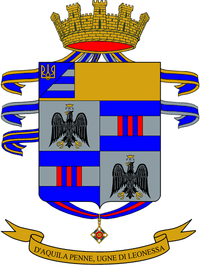 9th Alpini Regiment
9th Alpini Regiment  L'Aquila Battalion in L'Aquila
L'Aquila Battalion in L'Aquila -
 1 Mountain Artillery Regiment
1 Mountain Artillery Regiment  Aosta group in Fossano
Aosta group in Fossano -
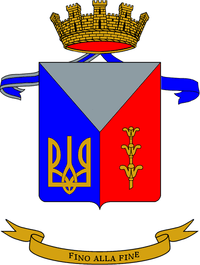 32° Alpini Engineer Regiment
32° Alpini Engineer Regiment  30th Battalion in Turin
30th Battalion in Turin -
 Taurinense Logistic Regiment
Taurinense Logistic Regiment  in Rivoli
in Rivoli
Equipment
The Alpini companies of the Alpini regiments are equipped with Bv 206S tracked all-terrain carriers, Puma 6x6 wheeled armored personnel carriers and Lince light multirole vehicles. The mortar companies of the Alpini regiments are equipped with 120mm mortars, while the anti-tank companies field Spike anti-tank guided missile systems. The Cavalry regiment is equipped with a mix of Centauro tank destroyers and Puma 4x4 wheeled armored personnel carriers. The artillery regiment of the brigade fields 18x FH-70 towed howitzers.
Sources
Italian Army Homepage: History of the Alpine Brigade Taurinense
| ||||||
